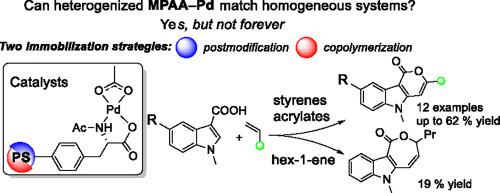聚合物支持的双CH功能化MPAA-Pd催化剂:匹配均相效率,同时揭示可回收性限制
IF 5.1
3区 工程技术
Q1 CHEMISTRY, APPLIED
引用次数: 0
摘要
MPAA-Pd催化剂广泛应用于烃类官能化,但其多相化作用尚未得到充分研究。我们通过n -乙酰基酪氨酸衍生物的共聚和后功能化开发了聚合物负载的MPAA-Pd催化剂。在优化的条件下,它们在13种衬底上的均匀性能(收率高达64%)相匹配,并且产品中的残留Pd降低了29%(2527±425比3556±479 ppm)。然而,可回收性很差:由于Pd浸出,在第二循环中,产率从65%下降到16%。XPS证实了在翻转过程中Pd(II)的部分还原,而聚合物的化学性质保持不变。结果表明,pd -羧酸盐配位在基本条件下具有固有的不稳定性,限制了该固定策略的可行性。这项工作说明了异质系统作为机械探针的价值,即使当合成效用被证明是有限的。本文章由计算机程序翻译,如有差异,请以英文原文为准。

Polymer-supported MPAA–Pd catalysts for dual CH functionalization: Matching homogeneous efficiency while revealing recyclability limits
MPAA–Pd catalysts are widely used in C![]() H functionalization, but their heterogenization remains underexplored. We developed polymer-supported MPAA–Pd catalysts by copolymerization and post-functionalization of N-acetyltyrosine derivatives. Under optimized conditions, they matched homogeneous performance across 13 substrates (up to 64 % yield) and showed ∼29 % lower residual Pd in the product (2527 ± 425 vs. 3556 ± 479 ppm). However, recyclability was poor: yield dropped from 65 % to 16 % in the second cycle due to Pd leaching. XPS confirmed partial Pd(II) reduction during turnover, while the polymer remained chemically intact. The results reveal that Pd–carboxylate coordination is inherently unstable under basic conditions, limiting the viability of this immobilization strategy. This work illustrates the value of heterogenized systems as mechanistic probes, even when synthetic utility proves limited.
H functionalization, but their heterogenization remains underexplored. We developed polymer-supported MPAA–Pd catalysts by copolymerization and post-functionalization of N-acetyltyrosine derivatives. Under optimized conditions, they matched homogeneous performance across 13 substrates (up to 64 % yield) and showed ∼29 % lower residual Pd in the product (2527 ± 425 vs. 3556 ± 479 ppm). However, recyclability was poor: yield dropped from 65 % to 16 % in the second cycle due to Pd leaching. XPS confirmed partial Pd(II) reduction during turnover, while the polymer remained chemically intact. The results reveal that Pd–carboxylate coordination is inherently unstable under basic conditions, limiting the viability of this immobilization strategy. This work illustrates the value of heterogenized systems as mechanistic probes, even when synthetic utility proves limited.
求助全文
通过发布文献求助,成功后即可免费获取论文全文。
去求助
来源期刊

Reactive & Functional Polymers
工程技术-高分子科学
CiteScore
8.90
自引率
5.90%
发文量
259
审稿时长
27 days
期刊介绍:
Reactive & Functional Polymers provides a forum to disseminate original ideas, concepts and developments in the science and technology of polymers with functional groups, which impart specific chemical reactivity or physical, chemical, structural, biological, and pharmacological functionality. The scope covers organic polymers, acting for instance as reagents, catalysts, templates, ion-exchangers, selective sorbents, chelating or antimicrobial agents, drug carriers, sensors, membranes, and hydrogels. This also includes reactive cross-linkable prepolymers and high-performance thermosetting polymers, natural or degradable polymers, conducting polymers, and porous polymers.
Original research articles must contain thorough molecular and material characterization data on synthesis of the above polymers in combination with their applications. Applications include but are not limited to catalysis, water or effluent treatment, separations and recovery, electronics and information storage, energy conversion, encapsulation, or adhesion.
 求助内容:
求助内容: 应助结果提醒方式:
应助结果提醒方式:


